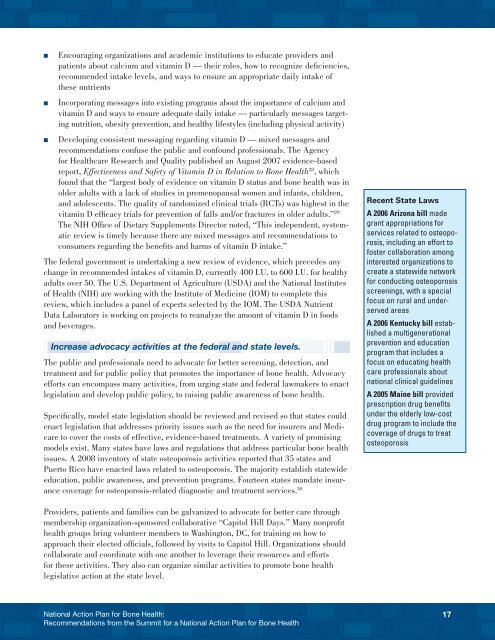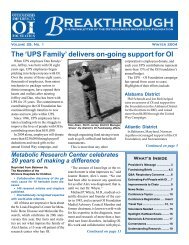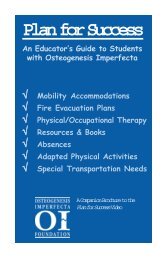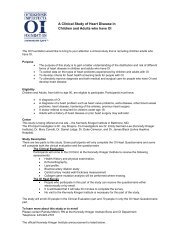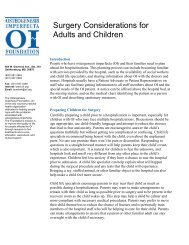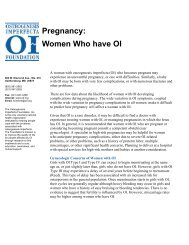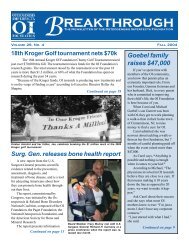National Action Plan for Bone Health - Osteogenesis Imperfecta ...
National Action Plan for Bone Health - Osteogenesis Imperfecta ...
National Action Plan for Bone Health - Osteogenesis Imperfecta ...
Create successful ePaper yourself
Turn your PDF publications into a flip-book with our unique Google optimized e-Paper software.
n<br />
n<br />
n<br />
Encouraging organizations and academic institutions to educate providers and<br />
patients about calcium and vitamin D — their roles, how to recognize deficiencies,<br />
recommended intake levels, and ways to ensure an appropriate daily intake of<br />
these nutrients<br />
Incorporating messages into existing programs about the importance of calcium and<br />
vitamin D and ways to ensure adequate daily intake — particularly messages targeting<br />
nutrition, obesity prevention, and healthy lifestyles (including physical activity)<br />
Developing consistent messaging regarding vitamin D — mixed messages and<br />
recommendations confuse the public and confound professionals. The Agency<br />
<strong>for</strong> <strong>Health</strong>care Research and Quality published an August 2007 evidence-based<br />
report, Effectiveness and Safety of Vitamin D in Relation to <strong>Bone</strong> <strong>Health</strong> 28 , which<br />
found that the “largest body of evidence on vitamin D status and bone health was in<br />
older adults with a lack of studies in premenopausal women and infants, children,<br />
and adolescents. The quality of randomized clinical trials (RCTs) was highest in the<br />
vitamin D efficacy trials <strong>for</strong> prevention of falls and/or fractures in older adults.” 29<br />
The NIH Office of Dietary Supplements Director noted, “This independent, systematic<br />
review is timely because there are mixed messages and recommendations to<br />
consumers regarding the benefits and harms of vitamin D intake.”<br />
The federal government is undertaking a new review of evidence, which precedes any<br />
change in recommended intakes of vitamin D, currently 400 I.U. to 600 I.U. <strong>for</strong> healthy<br />
adults over 50. The U.S. Department of Agriculture (USDA) and the <strong>National</strong> Institutes<br />
of <strong>Health</strong> (NIH) are working with the Institute of Medicine (IOM) to complete this<br />
review, which includes a panel of experts selected by the IOM. The USDA Nutrient<br />
Data Laboratory is working on projects to reanalyze the amount of vitamin D in foods<br />
and beverages.<br />
Increase advocacy activities at the federal and state levels.<br />
The public and professionals need to advocate <strong>for</strong> better screening, detection, and<br />
treatment and <strong>for</strong> public policy that promotes the importance of bone health. Advocacy<br />
ef<strong>for</strong>ts can encompass many activities, from urging state and federal lawmakers to enact<br />
legislation and develop public policy, to raising public awareness of bone health.<br />
Specifically, model state legislation should be reviewed and revised so that states could<br />
enact legislation that addresses priority issues such as the need <strong>for</strong> insurers and Medicare<br />
to cover the costs of effective, evidence-based treatments. A variety of promising<br />
models exist. Many states have laws and regulations that address particular bone health<br />
issues. A 2008 inventory of state osteoporosis activities reported that 35 states and<br />
Puerto Rico have enacted laws related to osteoporosis. The majority establish statewide<br />
education, public awareness, and prevention programs. Fourteen states mandate insurance<br />
coverage <strong>for</strong> osteoporosis-related diagnostic and treatment services. 30<br />
Recent State Laws<br />
A 2006 Arizona bill made<br />
grant appropriations <strong>for</strong><br />
services related to osteoporosis,<br />
including an ef<strong>for</strong>t to<br />
foster collaboration among<br />
interested organizations to<br />
create a statewide network<br />
<strong>for</strong> conducting osteoporosis<br />
screenings, with a special<br />
focus on rural and underserved<br />
areas<br />
A 2006 Kentucky bill established<br />
a multigenerational<br />
prevention and education<br />
program that includes a<br />
focus on educating health<br />
care professionals about<br />
national clinical guidelines<br />
A 2005 Maine bill provided<br />
prescription drug benefits<br />
under the elderly low-cost<br />
drug program to include the<br />
coverage of drugs to treat<br />
osteoporosis<br />
Providers, patients and families can be galvanized to advocate <strong>for</strong> better care through<br />
membership organization-sponsored collaborative “Capitol Hill Days.” Many nonprofit<br />
health groups bring volunteer members to Washington, DC, <strong>for</strong> training on how to<br />
approach their elected officials, followed by visits to Capitol Hill. Organizations should<br />
collaborate and coordinate with one another to leverage their resources and ef<strong>for</strong>ts<br />
<strong>for</strong> these activities. They also can organize similar activities to promote bone health<br />
legislative action at the state level.<br />
<strong>National</strong> <strong>Action</strong> <strong>Plan</strong> <strong>for</strong> <strong>Bone</strong> <strong>Health</strong>:<br />
Recommendations from the Summit <strong>for</strong> a <strong>National</strong> <strong>Action</strong> <strong>Plan</strong> <strong>for</strong> <strong>Bone</strong> <strong>Health</strong><br />
17


